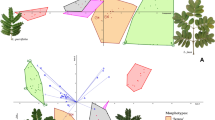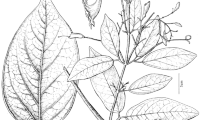Abstract
Cycads (Cycadales) are among the most ancient lineages of extant seed-bearing plants and are the most threatened plant order on Earth, with circa 75% of the 356 accepted species endangered or threatened with extinction. Zamia is the most species-rich (81 spp.) and widely distributed cycad genus in the Americas, notable for its morphological and ecological diversity. Across the genus, there appears to be a high degree of convergence among macromorphological traits, with many characters that are useful for species identification proving uninformative for elucidating relationships among species. However, it remains unknown whether anatomical variation in leaflet structure corresponds with phylogenetic or geographic patterns, as has been investigated in Dioon and Cycas. Here, we present a broad comparative survey of leaflet anatomy across Zamia species with the goals of describing anatomical diversity and uncovering diagnostic characters for resolved clades. Anatomical characters were scored based on the literature and newly prepared sections of leaflets from 20 Zamia species plus the outgroup species Microcycas calocoma. The resulting matrix covers 39 Zamia species representing all five major clades and spanning the geographic distribution of the genus. Anatomical characters scored from leaflet sections were mapped onto a previously published phylogeny and evaluated for their phylogenetic signal. Most anatomical characters examined are not diagnostic for clades, but newly reported mesophyll sclereids may be unique to one large lineage. Given the widespread incongruence between phylogenetic relationships and the distribution of anatomical traits, we tested the relationship between anatomical characters and environmental signals but did not uncover significant correlations between anatomy and ecology. While further work is required to elucidate the evolutionary history of anatomical characters in this genus, this research improves our understanding of micromorphological character evolution, anatomical diversity, and phylogenetic relationships within this highly threatened lineage of plants.





Similar content being viewed by others
Data Availability
All data necessary to evaluate this manuscript are included. Slide images are housed at the Cornell University Plant Anatomy Collection (CUPAC), Ithaca, New York and living specimens are maintained at Montgomery Botanical Center and Fairchild Tropical Garden in Coral Gables, Florida.
References
Acuña-Castillo, R., and Marín-Méndez, W. 2012. Some aspects of the foliar anatomy of two Zamia species from Costa Rica: Z. fairchildiana L. D. Gómez and Z. neurophyllidia D. W. Stev. Proceedings of Cycad 2008. The 8th International Conference on Cycad Biology, Panama City, Panama, 13–15 January 2008: 192–203.
Acuña-Castillo, R., and Marín-Méndez, W. 2013a. Comparative anatomy of leaflets of Zamia acuminata and Z. pseudomonticola (Zamiaceae) in Costa Rica. Revista de Biología Tropical 61, 539–546.
Acuña-Castillo, R., and Marín-Méndez, W. (2013b). Leaflet anatomy of Zamia disodon D.W. Stev. & sabato and Z. restrepoi (D.W. Stev.) A. Lindstr. Caldasia 35, 1–9.
Calonje, M., Meerow, A.W., Griffith, M.P., Salas-Leiva, D., Vovides, A.P., Coiro, M., and Francisco-Ortega, J. (2019). A Time-Calibrated Species Tree Phylogeny of the New World Cycad Genus Zamia L. (Zamiaceae, Cycadales). International Journal of Plant Sciences 180, 286–314.
Caputo, P., Cozzolino, S., Gaudio, L., Moretti, A., and Stevenson, D.W. (1996). Karyology and Phylogeny of Some Mesoamerican Species of Zamia (Zamiaceae). American Journal of Botany 83, 1513–1520.
Caputo, P., Cozzolino, S., De Luca, P., Moretti, A., and Stevenson, D. (2004). Molecular phylogeny of Zamia (Zamiaceae). Cycad Classification: Concepts and Recommendations 149–158.
Coiro, M., Jelmini, N., Neuenschwander, H., Calonje, M.A., Vovides, A.P., Mickle, J.E., and Lumaga, M.R.B. (2020). Evolutionary signal of leaflet anatomy in the Zamiaceae. American Journal of Botany 181:7, 697–1715.
Ehmig, M., Coiro, M., and Linder, H. (2018). Ecophysiological strategy switch through development in heteroblastic species of mediterranean ecosystems - An example in the African Restionaceae. Annals of Botany 123.
Esau, K. (1960). Anatomy of Seed Plants (Wiley).
Greguss, P. (1968). Xylotomy of the living cycads, with a description of their leaves and epidermis (Budapest: Akadémiai Kiadó).
Griffith, M.P., Magellan, T.M., and Tomlinson, P.B. (2014). Variation in Leaflet Structure in Cycas (Cycadales: Cycadaceae): Does Anatomy Follow Phylogeny and Geography? International Journal of Plant Sciences 175, 241–255.
Gutiérrez-Ortega, J.S., Yamamoto, T., Vovides, A.P., Farrera, M.A., Martínez, J., Molina-Freaner, F., Watano, Y., and Kajita, T. (2018). Aridification as a driver of biodiversity: A case study for the cycad genus Dioon (Zamiaceae). Annals of Botany 121, 47–60.
Hermsen, E.J., Taylor, T.N., Taylor, E.L., and Stevenson, D.W. (2006). Cataphylls of the Middle Triassic cycad Antarcticycas schopfii and new insights into cycad evolution. American Journal of Botany 93, 724–738.
Heide-Jorgensen, H. S. (1990). Xeromorphic leaves of Hakea suaveolens R. Br. IV. Ontogeny, structure and function of the sclereids. Australian journal of Botany, 38(1), 25–43.
Jones, D.L. (2002). Cycads of the World (Washington, D.C.: Smithsonian Institution Press).
Karabourniotis, G. (1998). Light-guiding function of foliar sclereids in the evergreen sclerophyll Phillyrea latifolia: a quantitative approach. Journal of Experimental Botany 49, 739–746.
Lamb, M.A. (1923). Leaflets of Cycadaceae. Botanical Gazette 76, 185–202.
Maddison, W. P. and D.R. Maddison. (2019). Mesquite: a modular system for evolutionary analysis. Version 3.61 http://www.mesquiteproject.org
Meerow, A.W., Salas-Leiva, D.E., Calonje, M., Francisco-Ortega, J., Griffith, M.P., Nakamura, K., Jiménez-Rodríguez, F., Lawrus, J., and Oberli, A. (2018). Contrasting Demographic History and Population Structure of Zamia (Cycadales: Zamiaceae) on Six Islands of the Greater Antilles Suggests a Model for Population Diversification in the Caribbean Clade of the Genus. International Journal of Plant Sciences 179, 730–757.
Nagalingum, N.S., Marshall, C.R., Quental, T.B., Rai, H.S., Little, D.P., and Mathews, S. (2011). Recent Synchronous Radiation of a Living Fossil. Science 334, 796–799.
Norstog, K.J. (1981). Karyotypes of Zamia (Cycadales). Caryologia 34, 255–260.
Norstog, K., and Nicholls, T.J. (1997). The Biology of the Cycads (Ithaca, N.Y: Comstock Publishing Associates).
Nyffeler, R., Eggli, U., and Leuenberger, B.E. (1997). Noteworthy idioblastic sclereids in the stems of Eulychnia (Cactaceae). American Journal of Botany 84, 1192–1197.
Pérez-Farrera, M.A., Vovides, A.P., Avendaño, S., and Herendeen, E.P.S. (2014). Morphology and Leaflet Anatomy of the Ceratozamia norstogii (Zamiaceae, Cycadales) Species Complex in Mexico with Comments on Relationships and Speciation. International Journal of Plant Sciences 175, 110–121.
Pérez-Farrera, M.A., Vovides, A.P., Ruiz Castillejos, C., Galicia, S., Cibrian, A., and López, S. (2016). Anatomy and morphology suggest a hybrid origin of Zamia katzeriana (Zamiaceae). Phytotaxa 270, 161-181.
Rao, T.A., and Bhattacharya, J. (1978). A Review on Foliar Sclereids in Angiosperms. Nelumbo 20, 91–99.
Rao, T.A., and Bhupal, O. (1973). Typology of sclereids. Proceedings of the Indian Academy of Sciences - Section B 77, 41–55.
R Core Team (2020). R: A language and environment for statistical computing. R Foundation for Statistical Computing, Vienna, Austria. URL https://www.R-project.org/.
Salas-Leiva, D.E., Meerow, A.W., Calonje, M., Griffith, M.P., Francisco-Ortega, J., Nakamura, K., Stevenson, D.W., Lewis, C.E., and Namoff, S. (2013). Phylogeny of the cycads based on multiple single-copy nuclear genes: congruence of concatenated parsimony, likelihood and species tree inference methods. Annals of Botany 112, 1263–1278.
Segalla, R., and Calonje, M. (2019). Zamia brasiliensis, a new species of Zamia (Zamiaceae, Cycadales) from Mato Grosso and Rondônia, Brazil. Phytotaxa 404, 1–11.
Stevenson, D.Wm. (1990). Morphology and systematics of the Cycadales. Memoirs of the New York Botanical Garden 57, 8–55.
Stevenson, D.Wm., Norstog, K.J., and Molsen, D.V. (1996). Midribs of Cycad Pinnae. Brittonia 48, 67–74.
Vovides, A.P. (1983). Systematic studies on the Mexican Zamiaceae. I. Chromosome numbers and karyotypes. American Journal of Botany 70, 1002–1006.
Vovides, A.P. (1991). Cone Idioblasts of Eleven Cycad Genera: Morphology, Distribution, and Significance. Botanical Gazette 152(1): 91–99.
Vovides, A.P., and Galicia, S. (2016). G-fibers and Florin ring-like structures in Dioon (Zamiaceae). Botanical Sciences 94(2): 263–268.
Vovides, A.P., Avendaño, S., Pérez-Farrera, M.A., and Stevenson, D.W.M. (2012). What is Ceratozamia brevifrons (Zamiaceae)? Brittonia 64, 35–42.
Vovides, A.P., Clugston, J., Gutiérrez-Ortega, J.S., Farrera, M.A., Tinoco, M.Y., and Galicia, S. (2018). Epidermal morphology and leaflet anatomy of Dioon (Zamiaceae) with comments on climate and environment. Flora - Morphology Distribution Functional Ecology of Plants 239, 20–44.
Vovides, A.P., Norstog, K., Fawcett, P.K.S., Duncan, M., Nash, R., and Molsen, D. (1993). Histological changes during maturation in male and female cones of the cycad Zamia furfuracea and their significance in relation to pollination biology. Botanical Journal of the Linnean Society 111, 241–252.
Vovides, A.P., Pérez-Farrera, M.A., Gutiérrez-Ortega, J.S., Avendaño, S., Medina-Villarreal, A., González-Astorga, J., and Galicia, S. (2020). A revision of the Ceratozamia miqueliana (Zamiaceae) species complex based on analyses of leaflet anatomical characters. Flora 270, 151649.
Acknowledgements
We thank Patrick Griffith and the entire Montgomery Botanical Center staff for maintaining crucial living collections and making them freely available to scientists; P. Barry Tomlinson for generously providing his expertise and profound anatomical insight; Chad Husby and Yisu Santamarina for providing access to specimens at Fairchild Tropical Garden; Jennifer Svitko at the Cornell University Plant Anatomy Collection for assisting with imaging; Dennis Stevenson for assisting with identification of anatomical structures; Melissa Whitaker for field support; Rory Maher for making data collection possible; and members of the Specht Lab at Cornell University for providing helpful feedback throughout the project.
Funding
RAEG. was supported by a Cornell College of Agriculture and Life Sciences Alumni Association academic enrichment grant and an undergraduate research grant from the Dextra Undergraduate Research Endowment. SS was supported by National Science Foundation Postdoctoral Research Fellowship in Biology (1906333). Consejo Nacional de Ciencia y Tecnología (CB 2011–169468-B) awarded to APV provided partial funding for anatomy research on Mexican cycads.
Author information
Authors and Affiliations
Contributions
RAEG, SS, and CDS conceived of the project; MC, APV, MC, and MAG assisted in sampling design, methodology and anatomical insight; material preparation, data collection and analysis were performed by RAEG, SS, and MC.
Corresponding author
Ethics declarations
Conflict of interest
The authors declare that they have no conflict of interest.
Supplementary Information
Below is the link to the electronic supplementary material.
Rights and permissions
About this article
Cite this article
Glos, R.A.E., Salzman, S., Calonje, M. et al. Leaflet Anatomical Diversity in Zamia (Cycadales: Zamiaceae) Shows Little Correlation with Phylogeny and Climate. Bot. Rev. 88, 437–452 (2022). https://doi.org/10.1007/s12229-021-09272-0
Accepted:
Published:
Issue Date:
DOI: https://doi.org/10.1007/s12229-021-09272-0




